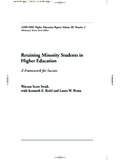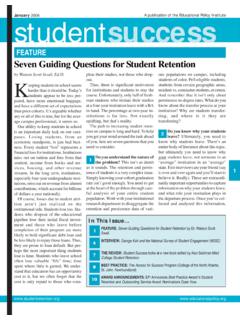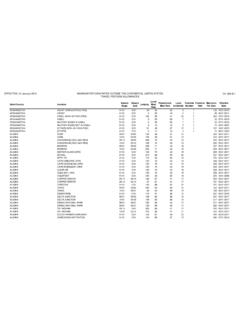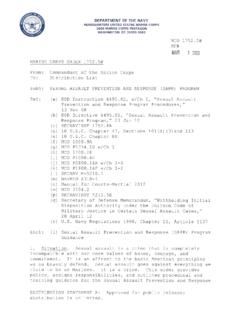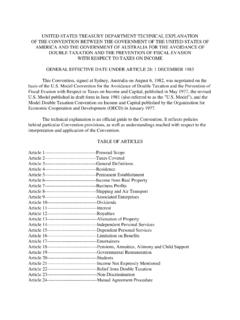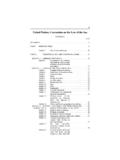Transcription of Certification and Teacher Preparation in the United States
1 Certification and Teacher Preparationin the United StatesBy David Roth and Watson Scott SwailPPAACCIIFFIICCRREESSOOUURRCCEESSFFO ORREEDDUUCCAATTIIOONNAANNDDLLEEAARRNNIIN NGGN ovember 2000 This publication provided courtesy of epiepi Educational Policy Institute Washington, DC Watson Scott Swail, President Improving educational policy & practice through research Washington Office 25 Ludwell Lane Stafford, VA 22554 1 (877) e-POLICY Los Angeles Office Occidental College 1600 Campus Road Los Angeles, CA 90041 1 (877) e-POLICY 1 CCCCEEEERRRRTTTTIIIIFFFFIIIICCCCAAAATTTT IIIIOOOONNNN AAAANNNNDDDD TTTTEEEEAAAACCCCHHHHEEEERRRR PPPPRRRREEEEPPPPAAAARRRRAAAATTTTIIIIOOOO NNNN IIIINNNN TTTTHHHHEEEE UUUUNNNNIIIITTTTEEEEDDDD SSSSTTTTAAAATTTTEEEESSSSBy David Roth and Watson Scott SwailINTRODUCTIONT eaching is more than picking up a bag of instructional tricks at the schoolroom door orlearning to mimic the actions of another educator even a very good one.
2 Good teachersare thinkers and problem solvers. They know when children aren t learning and canadjust instruction appropriately; they know how to design and use a variety of assessmenttechniques not just paper-and-pencil tests; they know how to work with parents to bringout the best in a child; they know that teams of professional educators can transformschools and expect to go about doing it. (Imig, 1996, p. 14A)ood teaching is perhaps the most critical part of a solid education. In fact, the deleterious effects ofjust one ineffective Teacher may jeopardize the entire educational success of a young person,regardless of how many effective teachers she might subsequently have (Wright, Horn, & Sanders,1997). The critical importance of teaching is not just acknowledged by educators and practitioners, but bythe public at large. A 1998 survey conducted by Louis Harris and Associates found that 55 percent ofAmericans chose the quality of teachers as the greatest influence on student learning (NEA, 1999).
3 Andgood teaching isn t an accident. Surely some teachers have a gift to help students learn, but knowledge ofthe learning process, child development, and academic content are all important components of quality has long been an important issue for parents, educators, and policymakers, to the extentthat new legislation was recently enacted by Congress to watchdog Teacher Preparation across the 207, as it is known in policy circles, was enacted as part of the reauthorization of the HigherEducation Act in 1998. This legislation requires colleges and state governments to report information onteacher quality, including pass rates on licensure examinations as well as the number of teachers holdingemergency or alternative certificates (see Appendix C for the legislation). The first such institutionalreport must be filed with the Department of Education by April 7, 2001, and States must comply byOctober 7, 2001.
4 Section 207 has the immediate impact of burdening colleges and state agencies with theresponsibility of collecting appropriate data, and if the data-collection systems aren t available, thosemust be developed as well. Complicating the law is that each state has its own set of licensure andcertification guidelines (see Appendices C & D).1 While the intent is in good faith, no one is really surewhat the congressionally mandated data will mean in the end due to the breadth of field practice acrossthe 50 States , the District of Columbia, Puerto Rico, and the Pacific Islands. What the law accomplishes isto set a tone for what is expected in Teacher Certification over the next several years. Quality counts, Teacher test scores, and other indicators will be need to recruit qualified teachers to serve the neediest communities and schools of the United Statesand the entities of the Pacific has never been more pronounced.
5 Regardless of geographiclocation whether it be Koror, Palau or Newark, New Jersey the most needy children and their schoolsare historically those who have suffered most from the tyranny of low expectations and paltry schools in our most affluent communities have historically had little trouble attracting andretaining quality teachers, economically challenged rural and urban schools have not kept pace with their 1In order to smooth out the process, the Teacher Preparation Accountability and Evaluation Commission (TPAEC)was created to provide technical assistance to the Department of Education. In its recent report on therequirements, TPAEC acknowledges the variance in institutions, and recommends that the States respect theindividuality of higher education institutions and don t use the reports to try to homogenize Teacher -preparationprograms in each state (AASCU, 2000, p.)
6 7).G2moneyed counterparts when it comes to staffing classrooms with well-prepared, licensed Pacific schools are staffed with faculty members barely out of high school themselves, individualswho have been granted licenses to teach having proven only minimum competence. Decades of debate oneducation reform have done little to address the Teacher crisis that exists for our neediest students, as isevidenced by the sheer numbers of new teachers required to meet the basic needs of our rural and inner-city the past twenty years, alternative methods of Teacher Certification have developed in response to thedire need for teachers in communities and schools across the United States and the Pacific. Schooldistricts and colleges have, in unprecedented numbers, begun to offer programs of Certification thatcircumvent many of the traditional requirements that were the hallmark of pedagogical training.
7 Thesealternative Teacher -training programs, first conceived as short-run responses to crisis, have becomeintegral parts of the educational landscape (Stoddart & Floden, 1995).To be sure, alternative models of Teacher Certification are not novel, but in fact mark a return to the rootsof Teacher education in the United States . Interestingly, until the advent of teachers colleges in the latenineteenth and early twentieth centuries, local school districts were most often the entities empoweredwith the authority to certify teachers. Alternative Certification programs represent a return to thatparadigm and further proof that there is in fact nothing new under the sun. This paper is being written primarily to help provide a wider lens through which one might view thesignificant Teacher -shortage dilemmas that affect schools and communities in the Pacific. We havedivided this paper into three sections.
8 Part I provides a perspective of the challenges facing teachereducation, recruitment, and quality in the United States . Part II focuses on issues of Certification andlicensure, with a specific look at the alternative and emergency Certification issues across the , Part III will provide discussion based on our findings, with recommendations and considerationswith respect to the conditions and critical Teacher -quality issues of the Pacific Island I: A CRITICAL PERSPECTIVEhe Pacific Island schools and school systems to which this study will be relevant differ greatly inpopulation, culture, economy, and resources from the communities and schools on the mainlandUnited States . However, the effect of Teacher shortages upon students, whether in Los Angeles, Pohnpei,Guam, or Milwaukee, is disturbingly similar. When there are not enough well-trained, well-supportedteachers, students suffer regardless of geography.
9 But the geography of the islands makes the task ofmaintaining quality of instruction even more difficult. The million people living in the Pacific regionare spread out over an area of million square miles, an area roughly equivalent to times that of thecontinental United shortages affect underserved communities and schools across the Mainland and the Pacific, allwith strikingly similar results. Those communities that are the wealthiest and the most homogeneous havehistorically had very little trouble recruiting well-qualified teachers. By contrast, high-poverty urban andrural schools are the ones most likely to suffer from debilitating Teacher shortages. Surprisingly, however,discourse about the shortage of well-qualified teachers on the Mainland most often revolves around thedilemmas facing urban, inner-city schools, while the opposite discussion is taking place in Pacificcommunities.
10 The plight of the Mainland s rural schools is not as well documented as the plight of therural schools in the Pacific, a condition that has forestalled significant national efforts to meet the uniqueneeds of the rural student. According to Collins (1999), Few States have developed specific programs toaddress the problems of rural Teacher recruitment and retention. Recent research on rural teacherrecruitment and retention appears thin, and much of it has been conducted outside the United States . To be sure, severe Teacher shortages affect almost every high-poverty urban and rural communitythroughout the mainland and the Pacific. We hope that as the light thrown upon the schools of thePacific illuminates the needs of the rural Mainland student, further study will be made of the needs of theyoung people and their families living outside of our suburbs and Teacher PoolAccording to the National Center for Education Statistics (NCES), an estimated million new teacherswill be needed by 2008-09 due to Teacher attrition and retirement.
